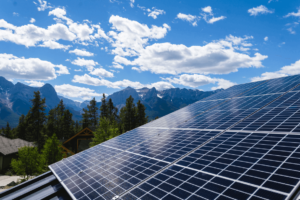The amount of energy each type of Solar Panels can generate is different.
Polycrystalline and monocrystalline solar panels
Monocrystalline panels have the best efficiency and power among panels of any type.
Monocrystalline Solar Panel Lahore can achieve over 20% efficiency, while polycrystalline solar panels often achieve 15 to 17% efficiency.
Monocrystalline solar panels produce more energy than other types of panels due to their efficiency and because they are available in higher power modules.
Most monocrystalline solar panels are over 300 watts (W) and some are over 400 watts recently.
The power of polycrystalline solar panels is lower.
This does not mean that polycrystalline and monocrystalline solar panels are physically incomparable; In fact, both types of solar panels typically have 60 silicon cells, of which 72 or 96 cell varieties are available (usually for large scale installations).

Thin film solar panels
Thin film solar panels are less efficient and have less power than polycrystalline or monocrystalline panels.
Efficiency varies depending on the type of material used in the cells, but is typically around 11%.
Unlike polycrystalline and monocrystalline solar panels, which are available in standard cell sizes of 60, 72 and 96, thin film technology does not.
As a result, the power of a single thin film panel will be largely determined by its physical size.
Polycrystalline and monocrystalline solar panels will, on average, have higher power per square foot than thin film panels.
Solar panels come in different price ranges.
Since the production methods of polycrystalline, monocrystalline and thin film panels are different, each type of panel has a different price.
Monocrystalline solar panels are expected to be the most expensive of all solar panel types.
This is primarily due to the manufacturing process: since solar cells are made up of a single crystal of silicon, manufacturers must pay the cost of manufacturing these crystals.
This method, called the consumes a lot of energy and wastes silicon (which could later be used to produce polycrystalline solar cells).
Polycrystalline solar panels are a good compromise.
Polycrystalline solar panels are often cheaper than monocrystalline ones.
The fact is that the cells are made up of silicon fragments, and not from a single pure silicon crystal.
This greatly simplifies the cell production process, saving both manufacturers and end users money.
The cost of thin film solar cells is mainly determined by the type of thin film solar cells; solar panels are generally the cheapest to manufacture, while CIGS solar panels are significantly more expensive to manufacture than either or amorphous silicon.
Due to the additional labor required, the total cost of installing a thin film solar panel system may be less than installing a polycrystalline and monocrystalline solar panel system, regardless of the prices of the panels themselves.
Thin film solar panels are less labor intensive to install because they are lighter and easier to maneuver, making it much easier for installers to lift panels onto rooftops and secure them in place.
This results in lower labor costs, which can contribute to a more affordable solar installation over.
Which types of solar panel is best for your installation?
Much of your decision as to which solar panel you want to use for your system will be based on the details of the situation and ownership.
Polycrystalline, monocrystalline and thin film panels have their own advantages and disadvantages, and the best option for you depends on the property and goals of your solar project.
Installing cheaper and lower efficiency polycrystalline panels can save money upfront for property owners who have plenty of space for solar panels.
Installing high efficiency monocrystalline solar panels is a good option if you have limited space and want to save on your energy bills.
When it comes to thin-film solar panels, they are most often used on huge commercial rooftops that cannot support the extra weight of typical solar equipment.
Because they have more room to accommodate thin-film panels, these types of roofs can also afford less efficiency.
Thin-film panels can also be useful for portable solar systems, such as those used in RVs or boats.
Frequently Asked Questions (FAQ)
How do solar panels and batteries work?
Solar panels allow you to consume electricity immediately after its creation.
On the other hand, solar panels are now available to store the energy generated by your panels during the day so you can use it later.
Solar panels come in many shapes and sizes, each with its own set of features and capabilities.
Some are the size of a car battery, while others are the size of a generator or washing machine.
Most people who install solar panels do so without a battery because they want to use power from the grid when the panels are not producing electricity.
Sunlife Solar are commonly used by people who seek to live off the grid.

How do solar panels work off grid?
The term “off-grid” refers to a location that is not connected to the national network.
As a result, autonomous solar panels require a battery to operate.
The autonomous system must be capable of:
- Produce enough energy all year round
Because batteries, inverters, and standby generators are expensive to maintain, these systems are often only found in isolated locations where grid connection is impractical.
Are solar panels efficient?
Solar panels are never 100% efficient because conditions are never perfect.
Most home panels have an efficiency of 20%, which may seem low, but sufficient to cover most (if not all) of a household’s energy use.
Recommended: Top Features to Look for in Patient Engagement Software





